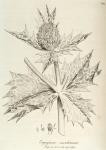
 font color="#99C68E">[Graeci Philosophi Eryngium, quasi (greek), id est ructum, dictum putant, quod caprae quae morsu surculum Eryngii praeciderint, vel deglutiverint, cunctum gregem pone sequentem quasi stupore attoituin futunt, donec Eryngium ructu rejecerint. C. Bauh. l. c.]
font color="#99C68E">[Graeci Philosophi Eryngium, quasi (greek), id est ructum, dictum putant, quod caprae quae morsu surculum Eryngii praeciderint, vel deglutiverint, cunctum gregem pone sequentem quasi stupore attoituin futunt, donec Eryngium ructu rejecerint. C. Bauh. l. c.]
Synonyma. Eryngium. Pharm. Lond. Bauh. Pin. p. 386.
Eryngium marinum. Gerard Emac. p. 1162. Park. Theat. p. 986. J. Bauh. Hist. vol. iii. p. 86. Raii Hist. p. 384. Synop. p. 222.
Eryngium maritimum. Bauh. Pinax. p. 386. Hudson. Flor. Ang. Withering. Bot. Arrang. p. 264. Flor. Dan. tab. 875.
Class Pentandria. Ord. Digynia. Lin. Gen. Plant. 324.
Ess. Gen. Ch. Flore's capitati. Receptaculum paleaceum.
Spec. Char. E. foliis radicalibus subrotundis plicatis spinosis, capitulis pedunculatis, paleis tricuspidatis.
The root is perennial, long, round, tough, externally of a brown colour, internally whitish: the stalk is thick, fleshy, round, striated, white, branched, and rises from one to two feet in height: the leaves, which grow from the root, are roundish, plaited, trifid, firm, spinous like those of the holly, marked with white reticulated veins, and of a very pale bluish green colour; those proceeding from the stalk are sessile, and surround the branches: the flowers are small, of a blue colour, and terminate the branches in round heads: the common receptacle is conical, and supplied with paleae, which separate the florets: the involucrum of the receptacle is composed of many pointed leaves, which are longer than the florets: the calyx consists of five erect: sharp leaves, placed above the germen: the corolla is composed of five oblong petals, with their points turned inwards: the filaments are five, slender, upright, longer than the corolla, and supplied with oblong antherae: the two styles are filiform, and furnished with simple stigmata: the germen is beset with short hairs, and stands beneath the corolla: the fruit is two oblong seeds, connected together. It grows abundantly on the sea coasts, and flowers from July till October.
In the Materia Medica of Linnaeus, and in almost all the foreign pharmacopoeias, the Eryngium campestre is considered to be the officinal plant: Geoffroy, however, has observed that the E. maritimum is by many thought to be a more powerful medicine, and Simon Paulli [Quadrip. p. 324.] gives it the preference; but Boerhaave [Hist. pl. T. i. p. 194.] attributes the same virtues to both, and indeed it seems of little importance which is preferred. Eryngo is supposed to be the (greek) of Dioscorides, [Lib. 3. c. 24. He recommends it ad menses obstructos, tormina, inflationes hepaticos, venena, venenatos morsus, episthotonicos, & comitiales.] who with other ancient writers speak highly of its medicinal efficacy. The root, which is the part directed for medicinal use, has no peculiar smell, but to the taste it manifests a grateful sweetness, and on being chewed for some time it discovers a light aromatic warmth or pungency. By Boerhaave this was esteemed the principal of the aperient roots, and he usually prescribed it as a diuretic and antiscorbutic: [Vide, l. c.] it has likewise been celebrated for its aphrodisiac powers. ["Non male tum Graiis florens Eryngus in hortis / Quaeritur: hunc gremio portet si nupta virentem / Nunquam inconcessos conjux meditabitur ignes." Rapinus in Boer. Hist. The root is frequently candied, or made into a sweet meat. The young flowering shoots boiled, have the flavour of asparagus. Lin. Flor. Suec.] But this and the other effects ascribed to Eryngo seem now to obtain very little credit.

